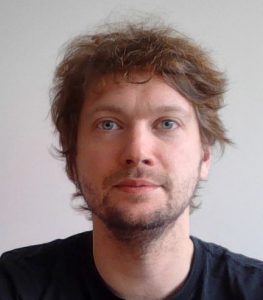 François Pasteau François Pasteau
Research Engineer
Insa de Rennes
Cursus
- 2008/2011: PHD in Signal and Image Processing at INSA de Rennes,
Laboratory IETR – UMR CNRS 6164, Group Image and Teledetection
Subject : Statistical study of a predictive codec for color images: a LAR-based robust and flexible framework
PHD Supervisor : Olivier Déforges – Co-supervisor : Marie Babel.
the 10th of november 2011, in front of :
- Bruno Arnaldi, INSA Rennes, PRU 27, Président,
- Jean-Marc Boucher, Télécom Bretagne, PRU 61, Rapporteur,
- Charly Poulliat, INP-ENSEEIHT Toulouse, PRU 61, Rapporteur,
- Frédéric Dufaux, Telecom ParisTech, DR au CNRS, Examinateur,
- Didier Nicholson, Thalès, Ingénieur de recherche, Examinateur,
- Marie Babel, INSA de Rennes, MCF 61, Encadrant de thèse,
- Olivier Déforges, INSA Rennes, PRU 61, Directeur de thèse.
-
2005/2008: Ingénieur Electronique et Informatique Industrielle Institut National des Sciences Appliquées (INSA) of Rennes (35)
Research Activities
Following my thesis work on image compression, I oriented my research towards assistive robotics through the setting up of the APASH project (Assistance au Pilotage pour l’Autonomie et la Sécurité des personnes Handicapées). Following the acceptance of this project, I joined the Lagadic team of Inria Rennes in September 2012 as a Research Engineer and APASH Scientific Manager for INSA.
The objective of the APASH project was to develop an embedded module for electric wheelchairs. Using a network of cameras and ultrasound sensors, this module can be used to assist the mobility of handicapped people, particularly when crossing doors.
In this context, my initial training in Industrial Computing allowed me to understand the problems of embedded and real-time systems. Moreover, my PhD in image processing gave me an innovative point of view on the theme of assistance robotics. These works concerning door detection have been the subject of 2 articles in international journals and 4 papers in international conferences with reading committee.
On the other hand, I contributed to the National Personally Assisted Living Action (AEN PAL). As such, I was the Robotic Operating System (ROS) platform referent for the Lagadic team within AEN PAL. I was also in charge of the design and development of the hardware and software platform for the APASH project.
Following the success of the APASH project, a maturation fund has been financed to allow the continuation of the work on the wheelchair and to allow the technological transfer of the solution to the Ergovie company. This maturation project called HandiViz allowed me to improve the solution that had been developed in the APASH project by optimizing it, making it more robust and testing it in a real situation. I was thus able to implement a series of tests with 25 patients suffering from different pathologies at the Saint Hélier cluster in Rennes. This work resulted in 2 publications in international conferences, an APP code deposit and 2 international patents. Based on the clinical tests that were carried out, another publication in the CVIU journal was accepted.
Following the success of the technology transfer, I was hired in 2015 by the company Ergovie in their research and development unit as R&D manager. This position within the company led me to manage 3 engineers in order to set up the commercialization of the obstacle avoidance solution. In 2016, I was responsible for the Ergovie company to set up a European Interreg Va project, in collaboration with industrials and laboratories in France and England. The aim of this project is, on the one hand, to design an intelligent electric wheelchair capable of moving autonomously indoors and outdoors and, on the other hand, to design a virtual reality electric wheelchair simulator allowing a better recommendation of the wheelchairs for first-time users.
I am also the leader of the PRISME project labeled by the Image and Network Pole in collaboration with the INSA of Rennes and the Physical Rehabilitation Pole Saint Hélier in Rennes. The aim of this project is to make a wheelchair and a communicating bed communicate in order to ensure a follow-up of the patient throughout his day.
In parallel with these research activities, during my time of activity within the Ergovie company, I was confronted with the difficulties of marketing technologies based on the medical device standard in a niche market such as the disability market. Following the closure of the Ergovie company, I was hired as a research engineer by the INSA of Rennes in order to continue my work on both the European ADAPT and PRISME projects.
More recently, I worked on the implementation of a collaboration between the INSA of Rennes and the Italian company ItalDesign in order to design an innovative travel vehicle for people with disabilities. This new vehicle will be presented at the Tokyo Paralympic Games in September 2020.
|
|